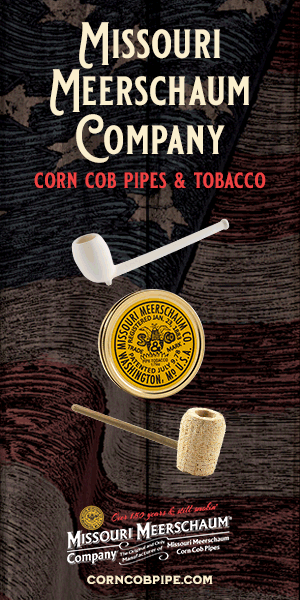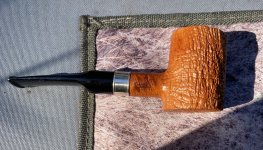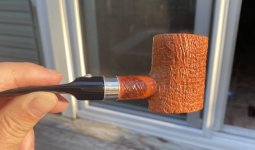Ruminations on the Porosity of Briar
- Thread starter Briar Lee
- Start date
You are using an out of date browser. It may not display this or other websites correctly.
You should upgrade or use an alternative browser.
You should upgrade or use an alternative browser.
SmokingPipes.com Updates
Watch for Updates Twice a Week
- Status
- Not open for further replies.
And it is colored on both side almost an equal amount. Just my current experience...
That’s exactly where meerschaum pipes color first.While not the same...
I have a new Barling that is three weeks old. The first pic was near the end of week 1 and the second was yesterday.
Notice the color change on the shank.
View attachment 173480
View attachment 173482
And while you’d never saw it in two, if you did the center of the shank would be natural color, only the first bit of the inside and outside stained. That’s exactly how meerschaums color, too.
Why doesn’t the center part color?
Briar pipes are waxed in order to sell pretty pipes.That wax penetrates a little, and acts as a barrier.
The smoke colors the wax.
All you need to do is sit and think about it.
Few mysteries remain unsolved, after enough thought is applied.
Because briar is not very porous?Why doesn’t the center part color?
Contrary to what you first claimed.
As others have noted, there is significant variation between pipes, briar can be very different due to growing location, climate, harvesting, processing, etc.
I have an old Medico that is rock hard, extremely dense, when I clean it, the inside of the chamber doesn't appear charred at all, even after many years of hard use.
I have a French made dublin shaped pipe with thick walls that visibly seeps liquids through the birdseye grain on the side, and another that has very thin walls and does not.
I have an Italian basket briar that is quite light for its size, has open grain structure, and is soft, easily dented with a fingernail, that has visibly coloured. I would bet that it is more porous than my dense old Medico that is the same colour now as when it was sold 50 years ago, but I'm not about to cut either one in half to find out.
I have an old Medico that is rock hard, extremely dense, when I clean it, the inside of the chamber doesn't appear charred at all, even after many years of hard use.
I have a French made dublin shaped pipe with thick walls that visibly seeps liquids through the birdseye grain on the side, and another that has very thin walls and does not.
I have an Italian basket briar that is quite light for its size, has open grain structure, and is soft, easily dented with a fingernail, that has visibly coloured. I would bet that it is more porous than my dense old Medico that is the same colour now as when it was sold 50 years ago, but I'm not about to cut either one in half to find out.
Dude I hate to tell you this but that's the only way Tara travels. She's a weird one.Tara travel completely through the pipe.
Tara's a wild one!Dude I hate to tell you this but that's the only way Tara travels. She's a weird one.
I see you know her too.Tara's a wild one!
I think Borer Lee and King Cobra JFS should debate the intricacies of briar pipe science on YouTube…
I cut a $300 IMP in half for the sake of discussion. Cut that thing in half or let the notion drop.
Last edited:
The gauntlet has been thrown down... Put up, or shut up.I cut a $300 IMP in half for the sake of discussion. Cut that thing in half or let the notion drop.
Cutting a perfectly good pipe in half is a waste and it doesn't prove anything for either side. People are entitled to their opinions and their observations of their own pipes.
What? Opinions, yes. Facts - what, we all now have our own facts?Cutting a perfectly good pipe in half is a waste and it doesn't prove anything for either side. People are entitled to their opinions and their observations of their own pipes.
If oils were to seep to the surface, they would not do so by leaving zero evidence in the middle. Capillary action simply doesn’t work that way, as is easily attested by simple middle school experiments. Heat darkens stain, oils, and various other substance on a pipe. Is it possible that a narrow stem might see oils and tars make it to the surface? Maybe. But I have only one pipe where that might be the case and it is a heavily smoked ancient. In any case, Lee’s observations are his - but …. Facts they aren’t.
Maybe? There's a photo of one at the top of this page and it occurred almost immediately.Is it possible that a narrow stem might see oils and tars make it to the surface? Maybe.
Last edited:
Apparently, wood is porous.
"Cellular Structure
Wood is a porous three dimensional, hydroscopic, interconnecting matrix of cellulose, hemicelluloses and lignin. In simple terms, a tree can be described as a bundle of vessels, its walls composed of cellulose glued together with lignin."
"Cellular Structure
Wood is a porous three dimensional, hydroscopic, interconnecting matrix of cellulose, hemicelluloses and lignin. In simple terms, a tree can be described as a bundle of vessels, its walls composed of cellulose glued together with lignin."
Sir, Your 'one pipe where that might be true' seems to be evidence that it is possible and therefore your proposition that it cannot be possible would seem untrue.What? Opinions, yes. Facts - what, we all now have our own facts?
If oils were to seep to the surface, they would not do so by leaving zero evidence in the middle. Capillary action simply doesn’t work that way, as is easily attested by simple middle school experiments. Heat darkens stain, oils, and various other substance on a pipe. Is it possible that a narrow stem might see oils and tars make it to the surface? Maybe. But I have only one pipe where that might be the case and it is a heavily smoked ancient. In any case, Lee’s observations are his - but …. Facts they aren’t.
I generally agree with many of your observations in other threads but you seem to be entrenching yourself into an indefensible position which seems unreasonable. Your proposition seems to defy simple logic and simple science. There are always exceptions to every proposition. I too have a briar pipe that has 3 areas of porous fine grain. I sanded the chamber and outside of the pipe. I wiped it with a clear mineral oil one night and set it aside. In the morning I observed a stain inside the chamber and no trace of the oil on the outside in the porous area... it seeped all the way through. I didn't need to cut the pipe in half. Was there a trace of oil all the way through ??? Probably under an electron microscope but I don't have one of those handy so to the naked eye it appears that no trace was left all the way through. Is that a fact ? For the purposes of this forum it is sufficient observable fact. For a peer reviewed study on porosity of wood for a doctoral dissertation ? Probably not.
By the way I have done extensive reading recently on heat transfer through wood and fire damage to wood specifically relating to wood grain and you might be surprised to learn that your suppositions may be wrong. The chinese universities have published some very good studies that were done for the purpose of preserving ancient wooden buildings as part of the country's historical preservation.
That grain continues to be a conduit for transfer long after the wood is carved into something else.
I was going to share all this in a post along with my similar observations as part of my restoration of my pipe with porous areas but apparently its too controversial a topic now.
But what is the point ? All Briar Lee was saying was that he has a pipe that he cleaned to natural and smoked it 4 times and it darkened from smoking. He has reached the conclusion the smoking and tobacco and tannons darkened it from the inside out. Maybe he's right and maybe he's wrong but you and others have no right to insist he believe what you believe or know and he destroy his pipe to prove you right. That's tyranny and despotism and this is a simple pipe smoking forum of enthusiasts ... lighten up. You may not like his style of writing but he is entitled to participate in a general discussion forum. Be nice.
Some of it floats too !Apparently, wood is porous.
"Cellular Structure
Wood is a porous three dimensional, hydroscopic, interconnecting matrix of cellulose, hemicelluloses and lignin. In simple terms, a tree can be described as a bundle of vessels, its walls composed of cellulose glued together with lignin."
I have no doubt it is possible for oils to seep through briar. I think I may have very well observed it and I have a Lee where this may very well be the case. But it is an exception and not a rule and if it was a rule, then we would observe this phenomena in the myriad estates we’ve collected.Sir, Your 'one pipe where that might be true' seems to be evidence that it is possible and therefore your proposition that it cannot be possible would seem untrue.
I generally agree with many of your observations in other threads but you seem to be entrenching yourself into an indefensible position which seems unreasonable. Your proposition seems to defy simple logic and simple science. There are always exceptions to every proposition. I too have a briar pipe that has 3 areas of porous fine grain. I sanded the chamber and outside of the pipe. I wiped it with a clear mineral oil one night and set it aside. In the morning I observed a stain inside the chamber and no trace of the oil on the outside in the porous area... it seeped all the way through. I didn't need to cut the pipe in half. Was there a trace of oil all the way through ??? Probably under an electron microscope but I don't have one of those handy so to the naked eye it appears that no trace was left all the way through. Is that a fact ? For the purposes of this forum it is sufficient observable fact. For a peer reviewed study on porosity of wood for a doctoral dissertation ? Probably not.
By the way I have done extensive reading recently on heat transfer through wood and fire damage to wood specifically relating to wood grain and you might be surprised to learn that your suppositions may be wrong. The chinese universities have published some very good studies that were done for the purpose of preserving ancient wooden buildings as part of the country's historical preservation.
That grain continues to be a conduit for transfer long after the wood is carved into something else.
I was going to share all this in a post along with my similar observations as part of my restoration of my pipe with porous areas but apparently its too controversial a topic now.
But what is the point ? All Briar Lee was saying was that he has a pipe that he cleaned to natural and smoked it 4 times and it darkened from smoking. He has reached the conclusion the smoking and tobacco and tannons darkened it from the inside out. Maybe he's right and maybe he's wrong but you and others have no right to insist he believe what you believe or know and he destroy his pipe to prove you right. That's tyranny and despotism and this is a simple pipe smoking forum of enthusiasts ... lighten up. You may not like his style of writing but he is entitled to participate in a general discussion forum. Be nice.
And I am nice to Mr. Lee. Unfortunately, forums are fairly one dimensional conversations and the history of PMs between members is not something the rest of our members are privy too.
Yes, I realize I may have backed myself into a corner somewhat. But I assure you, @Briar Lee would have it no other way.
If only our only tyranny was the vivisection of a pipe, this world would be a Cambelite Paradise. I am sure there is a song that says so.
- Status
- Not open for further replies.









